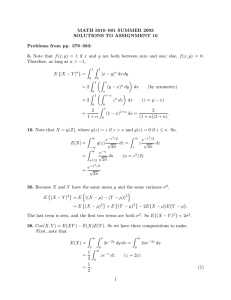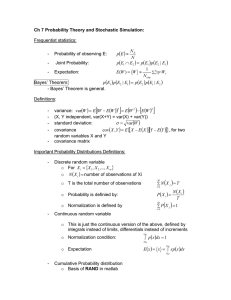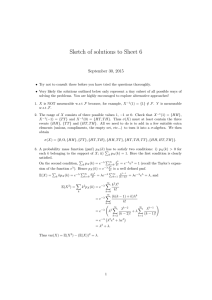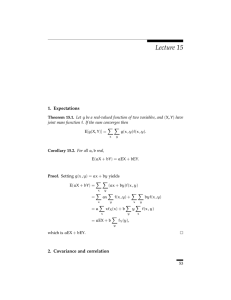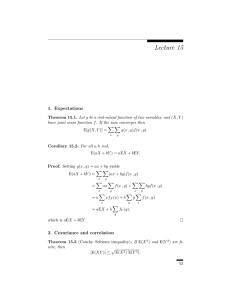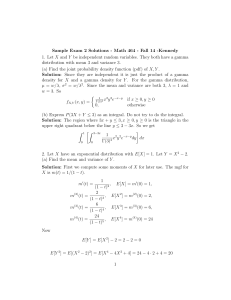Week #2: Probability
advertisement
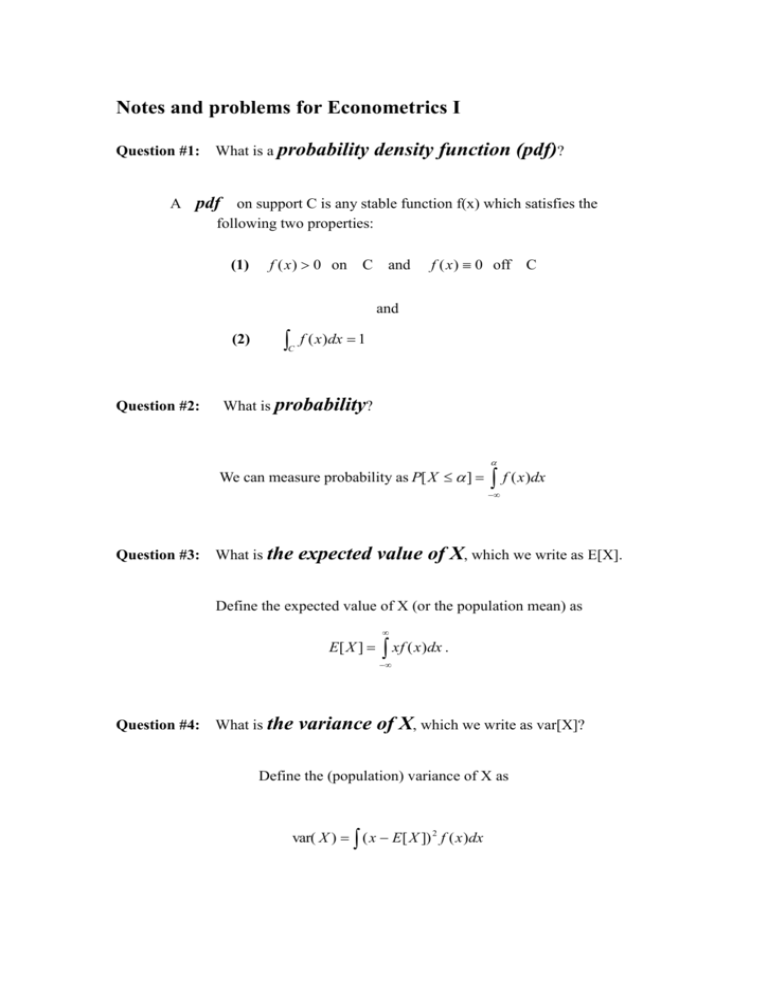
Notes and problems for Econometrics I
Question #1: What is a probability
density function (pdf)?
A pdf on support C is any stable function f(x) which satisfies the
following two properties:
(1)
f ( x ) 0 on
C
and
f ( x ) 0 off
C
and
(2)
Question #2:
C
f ( x )dx 1
What is probability?
We can measure probability as P[ X ]
f ( x)dx
Question #3: What is the
expected value of X, which we write as E[X].
Define the expected value of X (or the population mean) as
E[ X ]
xf ( x)dx .
Question #4: What is the
variance of X, which we write as var[X]?
Define the (population) variance of X as
var( X ) ( x E[ X ]) 2 f ( x )dx
Question #5: Show that the
Question #6: What is
var[X] = E[X2] – {E[X]}2.
the joint pdf of X and Y
(DIY)
on support C,
which we can write as f ( x, y ) ?
The function f(x,y) is a joint pdf if it satisfies two conditions:
(1)
f ( x, y ) 0 on
C
f ( x, y ) 0 off
and
C
and
(2)
C
f ( x, y )dxdy 1
Question #7: Suppose we have the random variables X and Y. What is the
definition of
the covariance of X and Y,
which
we write as cov[X,Y]?
Define the (population) covariance of X and Y as
cov( X , Y ) E[{ X E ( X )}{Y E (Y )}] ( x E[ X ])( y E[Y ]) f ( x, y ) dx dy
C
Note:
cov[X,Y] = E[XY] – E[X]E[Y]
Exercises:
#1. Discuss whether each f(x) is or is not a pdf.
a. f(x) = x-1 0 < x 1, α > 0
c. f(x) = exp{-0.5x2} - < x <
e. f(x) = ln{x} 0 < x < 1
b. f(x) = 1/2 0 x 1
d. f(x) = exp{-x} 0 x <
f. f(x) = (1/ln(2))(1/x) 1 x 2
#2. Find the expected values of X, given the pdf’s below for X.
a. f(x) = x-1 0 < x 1, α > 0
c. f(x) = 1
0x1
e. f(x) = 0.5
-1 x 1
b. f(x) = exp{-x} 0 x <
d. f(x) = {1/2}0. 5exp{-0.5x2} - < x <
f. f(x) = (1/ln(2))(1/x) 1 x 2
#3. Find the variances of W, given the pdf’s below for W
a. f(w) = w-1
0w1α>0
b.
c. f(w) = {1/2}0. 5exp{-0.5w2} - < w < d.
f(w) = exp{-w} 0 w <
f(w) = (1/ln(2))(1/w)
1w2
#4. Show that the following functions given below are joint pdf’s for U and V:
a. f(u,v) = 1 (u,v) [0,1] X [0,1]
b. f(u,v) = (2/ln(2))u/v (u,v) [0,1] X [1,2]
c. f(u,v) = {1/2}exp{-0.5(u2 + v2)} (u,v) R2
#5. Show that the covariances of P and Q, given the joint pdf’s below, are zero:
a. f(p,q) = {1/2}exp{-0.5(p2 + q2)} (p,q) R2
b. f(p,q) = (2/ln(2))p/q (p,q) [0,1] X [1,2]
